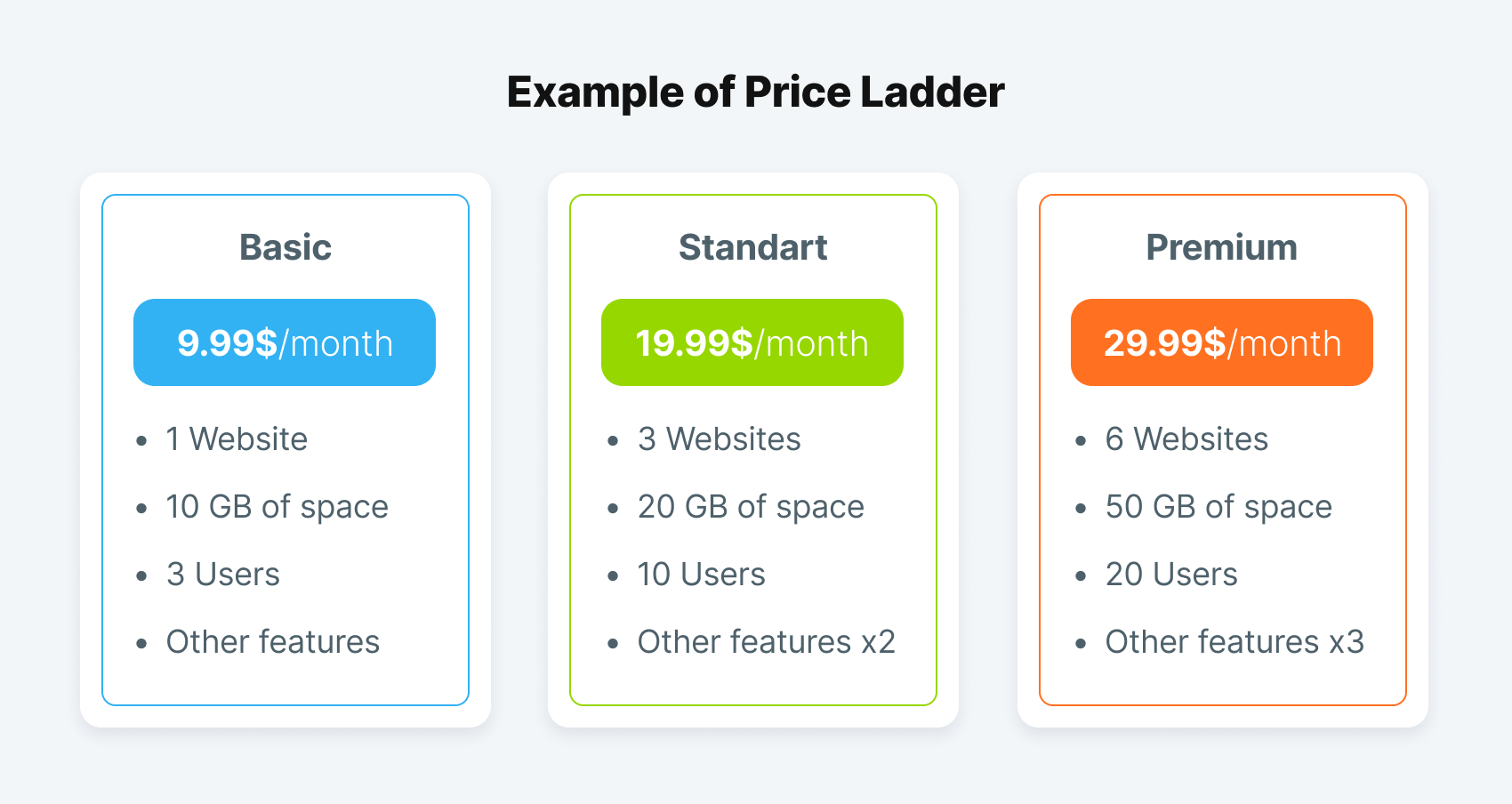Content navigation:
- Retail pricing ladders: 5 pointers for outstanding performance
- What are pricing ladders?
- Why your retail business needs pricing ladders
- 5 tips for flawless pricing ladder execution
- Getting started with using pricing software for your pricing ladder execution
- Conclusion
Retail Pricing Ladders: 5 Pointers for Outstanding Performance
Have you ever walked into a store and noticed different versions of the same product at varying price points? You might have a basic model for $9.99, a premium version loaded with extras for $19.99, and a top-of-the-line "best" option ringing in at $29.99. That's a pricing ladder strategy in action.
Retailers leverage these good-better-best pricing tiers to cater to diverse customer segments. From bargain hunters to luxury shoppers, a pricing ladder presents options tailored to different budgets and perceived values. When executed skillfully, it's a powerful sales strategy. Let's explore what pricing ladders are all about and how to implement them effectively.
What Are Pricing Ladders?
A pricing ladder plan (or good-better-best pricing) gives customers a vertically structured assortment of the same core product but at multiple price and feature levels. The anchoring "good" entry-level item hooks budget-conscious shoppers. Above it, the "better" mid-tier offers enhanced features and benefits at a higher cost. Finally, the premium "best" version justifies its luxury price tag through superior quality, materials, and extras.
The textbook example? Those tidy little hotel rooms you see advertised. The "good" is a bare room with limited amenities for $149/night. The "better" option at $249/night offers extra space and upgraded linens. The expensive "best" suite rings up to $399/night - but includes a jacuzzi tub, plush bathrobes, and stunning city views.

Why Your Retail Business Needs Pricing Ladders
While price laddering requires more planning than simple fixed pricing, it delivers significant upsides. These multi-tier strategies just make sense for retailers and customers.
Perception of Value
Humans are hard-wired to determine value through comparisons. We evaluate options side-by-side to decide what's "good enough" versus worth splurging on. Pricing ladders provide that ready-made comparison. Customers can easily see how spending more unlocks extra features and benefits they may deem valuable.
Increased Revenue Potential
With just one product version, you have a single price point to capture revenue. But add some "better" and "best" tiers, and suddenly, you're giving customers avenues to spend more. Those additional premium sales amp up your profit potential significantly.
Upselling Opportunities
Speaking of premium sales - laddering marketing is perfect for upselling once a customer is engaged. When presented with the full "good-better-best" menu, buyers often self-upgrade to a higher tier than initially intended. That slight uplift in average purchase size pays enormous dividends over time.
Competitive Positioning
In any product category, shoppers quickly identify the market leaders based on perceived quality and brand cachet. Pricing ladders and retail price monitoring help cement your position as a premier option. While competitors haggle over the entry-level "good" segment, you own the aspirational premium space.
Market Segmentation
Finally, pricing ladders inherently segment your customer base by income, taste levels, and willingness to pay for luxury. With smart positioning, you can dial in your ladder marketing to appeal to each specific tier - capturing everyone from frugal Value shoppers to affluent treat-yourself spenders.
5 Tips for Flawless Pricing Ladder Execution
Okay, so the benefits are clear. But how do you actually implement an effective, revenue-driving price ladder marketing strategy? The expected value of retail e-commerce sales worldwide in 2023 was $5.8 trillion. Estimates suggest that this amount will increase by 39 percent in the upcoming years and will top eight trillion dollars by 2027. This is a great opportunity to occupy your niche in the market and become a leader with the help of the price ladder! Follow these five essential tips:
Deeply Understand Your Customer
The first step is developing crystal-clear profiles of your core customer segments. What are their typical incomes, tastes, and spending motivations? Use qualitative and quantitative data to map out these buyer personas. This customer knowledge shapes how you'll structure and position each pricing tier.
Identify Your True Value Drivers
Certain features and benefits are overwhelmingly crucial to customers in any product category. You'll use those value drivers to separate and enhance your various "good-better-best" models. Is it materials like premium leather? Advanced technology under the hood? Luxury branding or scarcity? Define the value equation.
Establish Rational Pricing Gaps
With pricing ladders, those middle "better" and premium "best" tiers can't be mere token upgrades. There must be legitimately higher value and a meaningful pricing difference to make them motivating upsell opportunities. A good rule of thumb is to ensure that around 40% separates each rung on your ladder.
Tell a Compelling Upgrade Story
Even the most rationally designed pricing architecture will fall flat if you don't compellingly sell the value messaging. Craft persuasive content that paints a desire-building vision of what you'll get by climbing to the next pricing tier. Emphasize the features, benefits, and aspirational value prop at each level.
Leverage Behavioral Economics
Humans are funny decision-makers driven by quirks of psychology and perception. Strategic use of retail price management principles like anchoring, decoy pricing, and charm pricing can further nudge customers toward your more lucrative premium offerings. Look for opportunities to apply these behavioral economics "tricks."
Getting Started with Using Pricing Software for Your Pricing Ladder Execution
While pricing ladders seem straightforward in theory, the actual implementation and management are quite complex - particularly for retailers with extensive product catalogs and ever-changing market conditions. That's where pricing software solutions become invaluable.
Intelligent pricing tools use machine learning algorithms to crunch reams of data around consumer demand, competitor pricing, promotions, and more. The software can then automatically generate optimized pricing ladder recommendations customized for your specific goals. It takes the guesswork and manual overhead out of meticulous price coordination.
Many retailers are moving toward more dynamic, AI-powered pricing capabilities that adjust in real-time based on shifting market variables. With the right retail pricing tool, you can fluidly adapt all rungs of your pricing architecture, continuously optimizing your ladder in a plan.
Pricing Ladder Mastery Takes Practice
While powerful, pricing ladders require careful planning and ongoing price optimization in retail to sing truly. It's not just a set-it-and-forget-it strategy. Mature retailers monitor their ladder's performance, test variations in tier counts and positioning, and evolve their value-driving differentiators over time.
The good news? Mastering the nuances of pricing ladder excellence pays off exponentially in incremental revenue and profits. Even seemingly minor upticks in average purchase size or premium product sales can translate to millions for high-volume businesses as the compounding benefits accumulate.
So, be patient as you embark on multi-tier pricing. Leverage best practices, analyze the results, and keep fine-tuning. Before long, you'll be effortlessly ushering customers up the ladder toward bigger sales.
Conclusion
It will take some trial and error to see how effectively it can work for your company. A well-stocked pricing ladder that allows consumers to upsell themselves without assistance from salespeople. What more could a merchant want?






